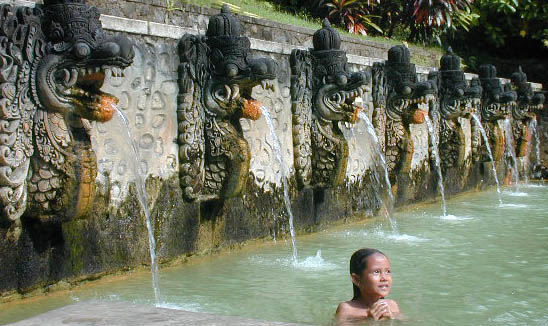
On the other hand, the ride there was quite an event. Bali is strewn with a maze of 1 1/2 lane roads plied by mammoth trucks and busses with size getting the right-of-way. We negotiated ancient blacktop strewn with glacier class crevasses and repeatedly dove off the shoulder as another behemoth lumbered by. On the back, Tuk was blissfully ignorant, driving, I was terrified.
The sights were mostly non-impressive, Pura Taman Ayun temple (again), Lake Bratan's Pura Ulan Danu temple, Gitgit waterfall, and Air Panas Banjar hotsprings. The highlight of the tour though was just being out of the cities and getting to see some of Bali's beautiful landscape. Steep volcanic mountain sides lined with coffee plantations and terraced rice farms, all like scenes from a picture book.
 |
| Air Panas Banjar hot springs. |
Our guide woke us at 3:30 a.m. so we could make the short drive and 2 hour trek to the top before sunrise. The hike is fairly easy and the views from the summit well worth it. The volcanic nature of the terrain, imperceptible from below, is readily apparent from the summit. The walls of the old caldera, several kilometers apart ring the entire area and cider cones dot the landscape.
Batur's volcanic nature is also obvious, the summit is pierced by a deep crater and steam hisses out of cracks and crannies everywhere. Our breakfast of steamed eggs and bananas is cooked by wrapping them in wet leaves and tucking them into steam filled vent.
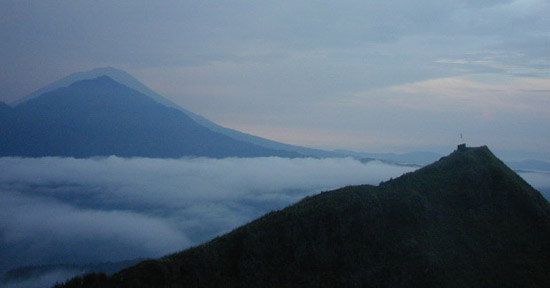 | |
| Sunrise from the summit of Mt Batur. That's Mt Agung (3,142m, 10,300ft) in the background. | |
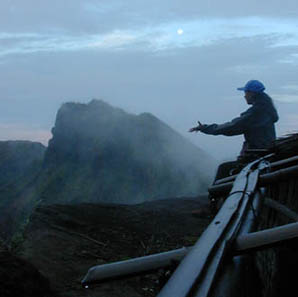 |
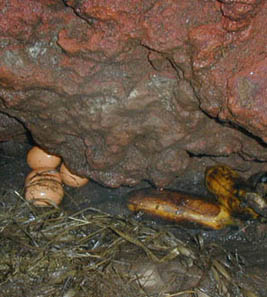 |
| Tuk on the edge of the caldera. | Cooking breakfast Volcano style. |
Bali, paradise or purgatory?Yes, there were a lot of touts. Walking down the streets of the main towns hardly a minute would pass (literally!) without someone trying to sell us something. "Transport? Dancing? Cold drink? Room? You want cigarette mister?" The offers were incessant, but for the most part they took their brush-offs well, and were not pushy. And although Bali is about as on the beaten track as you can get, it's not hard to get a sense of real Balinese life. A few minute scooter ride out of any of the main towns reveals small villages with people living their lives in blissful ignorance of the tourist trade. And actually, the commercialism makes things cheap and convenient. Door to door transport between towns and activities never cost more than a few dollars, and there certainly are a lot of activates. My biggest complaint with Bali wasn't the crass tourism, but rather that it just wasn't that nice. The beaches were average, the food and accommodation average, and many of the attractions were struggling just to make it to average. For me, it was all hype and no bite. |
The brochures promote Lombok as "The way Bali was 10 years ago," in theory untouched and unspoiled, but really the two are quite different. The culture on Bali is Balinese, while Lombok is 80% Muslim. In 1999 violence erupted between the Muslims and Christians and the tourists were evacuated. To a foreign eye things seem healed now but the bad press lingers, and on the brink of the high season we find Senggigi nearly empty. Hawkers outnumber tourists by about four to one and as we walk through town we trail them like a fox running from the hounds. Watches, bracelets, food, drugs, transport... No, I don't want any damnit!
We spent a relaxing day and then went out for what was supposed to be a "special" dinner. unfortunately at one of the nicest restaurants in town Tuk found live worms in her food, which turned her stomach and put a bit of a damper on things.
We took a Sasak cultural tour.
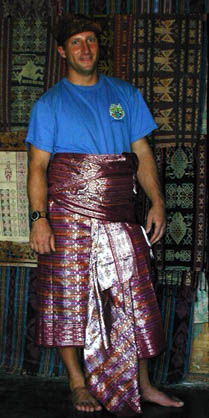 | |
| Me, dressed as a Sasak King (or so they told me). |
The Sasaks are the indigenous people of Lombok and today still comprise 90% of the population. They follow Islam, but still maintain a their own culture and traditions. The advertised goal of this tour was to provide a glimpse into traditional Sasak life.
Stop 1: Banyumulek, Pottery center
The first stop on our "cultural tour" was a major tourist trap. A big pottery market with a few token artisans about to demonstrate some of the skills. In their defense, if the hype is to be believed this market is a well organized co-op providing a steady income from many of the surrounding villages. Despite the overt commercial nature of this stop it was still interesting to see so many examples of the traditional (and not so traditional) Lombok pottery.
Stop 2: Kediri Traditional market
A traditional market maybe, but very similar to every other market I've seen in Asia. Everything on sale, from fruit and spices to truck axles.
Stop 3: Sukarara, Hand weaving village
Sukara was an actual village with weaving actually being done, it was very fun and interesting. A local guide showed us the entire process, growing the cotton, spinning the thread, brewing the natural dies, and weaving on the looms.
It's a village tradition that a young woman can not get married until she masters
all parts of the process and weaves her own bridal cloth. Tuk got to try her hand
at spinning, but it would seem her maidenhood is in no danger from Sukara.
The old woman demonstrating deftly pulled perfectly spun thread from wads of
fresh cotton, but no one else could do better than a snarled mass of short, broken
fibers.
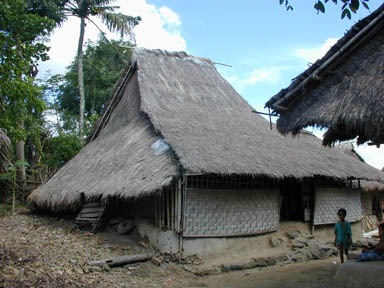 | |
| A traditional Sasak house. |
We acquired another local guide who showed us around a "traditional" Sasak village.
The houses were like the one pictured here. Inside they are divided into two rooms,
a small, enclosed inner room, and an outer room like a porch. When a couple first gets
married they build their own house and share the inner room until they have their first
child. After a child is born the wife is supposed to move out onto the porch. It's not
apparent how couples end up with more than one child.
Stop 5: Kuta beach
Not to be confused with it's trendy cousin in Bali, this Kuta beach is a quiet little stretch of sand in an isolated cove on the south coast of Lombok. There is a 5 star (corruption funded) hotel near by, but while we were there the only other visitors was a herd of buffalo munching on the sea grass.
Stop 6: Batu Bolong Temple
A Muslim temple that we weren't allowed inside, but it was perfectly situated to watch
the sun set behind the 3,142m (10,300 ft) volcano, Mt. Agung on neighboring Bali.
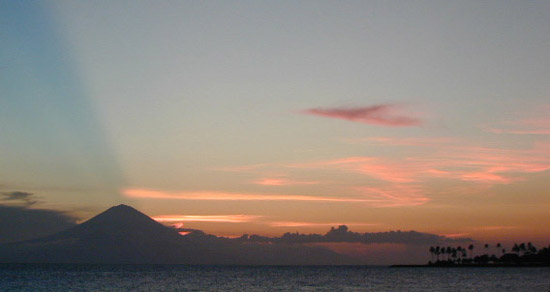 |
| Sunset over Mt Agung. |
One way to reduce the amount of nitrogen your body absorbs at depth is to fill the tanks with gas mix containing more oxygen, and thus less nitrogen (Nitrox). Unfortunately in high concentrations oxygen itself is toxic, and the deeper a diver goes the higher the concentration of oxygen it receives. Breathing compressed air at 40 meters (130 ft), is equivalent to breathing pure oxygen on the surface. Breathing compressed air at 65 meters (210 ft), the body receives a sufficient amount of oxygen to cause toxicity. The typical first symptom is convulsions. On the first convulsion the diver spits his or her regulator out, and on the second convulsion he or she inhales water and we are back to drowning. To go really deep divers blend a mix of gasses that wouldn't support life on the surface and then wait until they are deep enough before switching to that mix. Unfortunately, as you go deeper the pressure of nitrogen increases as well and causes a narcotic effect. So, just as the diver is faced with critical tasks like measuring bottom time, and switching gasses he or she finds themselves punch drunk! This is why to go very deep divers us a mix low in oxygen but with the nitrogen replaced with another inert gas (like helium). I didn't have the time to certify myself to the "tri-mix" level, but while we were on Gili Trawangan I took an introduction to enhanced air (EANX Nitrox) course and an advanced Nitrox/deep diving course. |
Of course, that's the boring part. The exciting part is that on the second dive we were tucked in a canyon hiding from the current when a school of four baby manta rays drifted into view and we got to sit and watch them for 10 minutes before we had to move on.
They are incredibly graceful creature, looking like a flying wings with menacing mandibles as they float through the currents sweeping up plankton and other tiny sea life. Even though they were small (1 meter across), a school of four is still a great sighting and this isn't even the season for them in the Gilis.
The dive itself is fabulous. It's a small wreck but full of life. It sits alone the sandy bottom home to a huge number of lion and stone fish.
p.m.: Night dive with Tuk, the final dive of her advanced course.
|
|